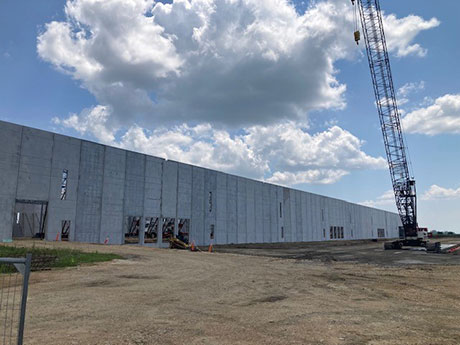By John G. Ruhl, NAI Ruhl Commercial Co.
People are always surprised when they learn how many communities are part of the Quad Cities since they think it stops with just four towns. For the record, there are 58. The bi-state region includes Moline, East Moline and Rock Island, Illinois, and Davenport and Bettendorf, Iowa, as the main core cities. The Quad Cities is the largest metro area between St. Louis and Minneapolis on the Mississippi River.
The Mississippi River was the main reason for this region’s initial growth historically since it was an important distribution channel. John Deere moved his base of operation to Moline, Illinois, in 1848 to utilize the river’s power for manufacturing and transportation of goods. The world headquarters of Deere & Co. are still based here, along with many of its factories and distribution centers, making it the region’s largest employer. Several other Fortune 500 companies have a major presence in this region, including Arconic, 3M, Nestle-Purina and Kraft Heinz.

The Quad Cities has always been led by smaller manufacturers, suppliers and service providers supporting our major employers and the regional economy. More than 1,200 manufacturers from all industry sectors are based in the Quad Cities.
Now, though, there is more than the Mississippi River connecting this region to the global economy. It is serviced by five freight railroads, an airport and major interstates such as I-80, I-88 and I-74 with close access to major markets of Chicago, Minneapolis, St. Louis, Milwaukee, Des Moines, Kansas City and Indianapolis.
Looking for land
The national surge in industrial real estate activity has extended to the Quad Cities region. There has been record-breaking new, speculative industrial development, extremely low vacancy rates (5 percent or less), and significant increases in lease rates and sales prices (10 to 20 percent) of industrial product over the past two years.
Locally, more new industrial development has happened in the past two years than in the past two decades. Much of this new development was speculative and quickly occupied to meet the wave of new demand. The bulk of this new development and leasing activity was in large distribution spaces of 100,000 square feet and larger that delivered the building amenities required by distribution companies today.
Smaller (10,000- to 30,000-square-foot) industrial buildings are difficult to find available for lease and more difficult to find for sale. If a quality industrial building becomes available, it is quickly snapped up by either an owner who intends to occupy it or an investor who will market the space for lease.
Amazon recently completed a 2.9 million-square-foot fulfillment center in the Eastern Iowa Industrial Center in north Davenport, Iowa. Fair Oaks Foods is building a new 150,000-square-foot production plant in the same vicinity.
Activity in transitional land in the Quad Cities region remains strong. However, high interest rates are taking some buyers out of the market. Land values have taken a pause in the upward growth that we experienced over the past several years. In the Quad Cities region, the market is best described as being stable with demand for land still considered to be good, especially for top quality parcels. However, in general, the supply of available land for sale and overall transactions are low compared with last year.
In the Quad Cities, there are several areas that are seeing increased activity. The TBK Bank Sports Complex area in Bettendorf continues to expand. The new Iron Tee Golf just opened, and a new $17 million SpringHill Suites by Marriott will be completed in 2025. QCR Holdings Inc. will build a new corporate headquarters with a banking branch in the area, bringing the first large office building and consistent daytime traffic to the surrounding strip malls, stores, businesses and restaurants. Birchwood Fields South, east of Utica Ridge Road on 53rd Street in Davenport, is another growing area featuring mixed-use developments.
Seeing smaller footprints
The Quad Cities region offers a strong mix of retail opportunities, including shopping centers, strip malls and standalone stores, providing ample opportunities for businesses to establish a presence and thrive in the market. Over the last year, we have seen an increase in retail market activity in big box spaces and smaller footprints.
However, it is important to note that deals are taking longer to put together. Despite this slower pace for deal completion, the retail market in our area remains robust with a variety of retail properties available for lease. Smaller neighborhood retail strip malls continue to be an opportunity for developers fulfilling demand by quick-service and drive-thru restaurants, coffee shops and service businesses.
During the pandemic, major metro areas saw very high office vacancy rates, but the Quad Cities was less than 18 percent because our region was not over-built. As office occupiers are slowly becoming active again locally, spaces leased are still often smaller in size (10,000 square feet or less) and a shorter lease term.
Lease rates for newly constructed office buildings have increased, not because of demand, but because of the cost of construction. Development of any new office building will require a 10-year lease term minimum. Our market has always been heavily owned by developers/investors and only available for lease. Good quality, functional office space for today’s needs that is available to purchase is more difficult to find.
The Quad Cities typically trails the trends of the larger markets by six to 12 months. As we navigate through the rest of 2024, we will watch the economic shifts to see if they bring more caution to the market.
John G. Ruhl is managing director of NAI Ruhl Commercial Co. This article originally appeared in the August 2024 issue of Heartland Real Estate Business magazine.


